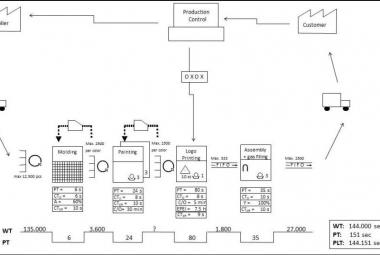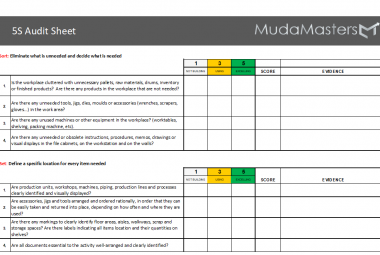5S is a very simple lean tool that, when implemented well, directly impacts productivity. It therefore forms the foundation of my Lean house for the Shopfloor, which I in 2017 transformed into the first level of lean maturity (Panneman, 2017).
5S improves productivity by reducing Muda (for instance products waiting to be worked on) Mura (for instance variance in cycle times because employees have to search for tools) and Muri (people getting stressed because of they can’t find the right tools in time to keep takt).
5S helps to keep only the necessary items at every workstation (sort), it prevents having people search for items (Straighten), helps people discover problems in an early stage (Sweep) and visualizes the agreements at every workplace (Standardize) (Panneman, 2019).
Some companies add a sixth “S”, for “Safety” to this list, to make sure safety is taken into consideration when designing a workplace. 5S is then usually turned into 6S, or 5+1S. While I agree that safety should always be taken into consideration when organizing a work place (for instance in terms of ergonomics), I choose to focus this book on the 5S principles and the goals that can be achieved with it in the way that is was originally described in lean literature.
Readers of my book Lean Transformations will remember that 5S is one of the tools used at the first level of lean maturity that describes setting the standards in your organization. Only if everybody who works on that workstation agrees on what the safest, most efficient way of working is, can they discuss the next possible improvements. If these standards are not in place, people may work in different ways, leading to variance in output, lead times, and communication errors because people may unwittingly talk about different problems.
By identifying and demonstrating how a workstation should be organized to work efficiently, and how the work in process is managed, deviations from the standard way of working can and will become visible to the trained observer. This is why 5S is considered a visual management tool. It helps to visualize deviations from the usual state of the workstation.
One good example of a 5S-related organizing technique is the shadow board, in which a board is hung on the wall adjacent to the work area. On the board are the tools that are being used by the operator at that workstation in a highly-visible and accessible manner. The classical implementation of this board involves painting the ‘shadows’ of the various tools in the location where a specific tool is supposed to be positioned. When the tool is not on the board, the visible shadow indicates that it is missing.
This can help you find or replace the tool before an operator needs it on the job, which can prevent the product from having to wait for the operator to find the tool.
This highlights an important part of 5S. It is not just the organizing of the workplace that brings you the benefits of an uncluttered workplace. It is the culture around using the visual standards that bring you the true efficiency benefits. If a tool on the shadow board is missing and nobody reacts to the visual signal; the missing tool can still lead to a delay in production, no matter how little useless tools can be found around the machine.
5S is therefore not just a technical tool, but a start of a culture in which people think and act in a way based on the visual cues that their workplace organization provides them.
Because of this cultural aspect, it is important for a 5S implementation to be successful that teams define their own 5S standards. This means that as a team is redesigning a specific workstation, they should be discussing whether a certain tool is needed and when to use it, so that they design their own visual cues. In doing so, they are not only working on the first stage of workplace organization, it is also the preparation for defining Standard Operating Procedures (SOPs) that contain the specific description of how a task is to be performed (which is the second tool described in the first level of Lean Maturity in my book Lean Transformations).
Now, before we go into more details on concept and principles in each of the 5S, let’s look at some instances in which 5S is applied to organize a space, without us even realizing it, or naming it 5S.
I have no doubt that your kitchen contains some 5S standards. You will have a fixed location for everything that you have in there. Pots and pans, cutlery, and glasses—everything is put in the same place every time. Chances are that the things you use most are kept in the place that is easiest for you to access when you need them. For example, coffee cups may be close to the coffee machine, and soap may be next to the sink. Kitchen appliances you need less often might be high up, at the back of cabinets, or even in another room if you don´t use them much.
All these “standards” for organizing the kitchen are (unconsciously) helping us to be efficient in the routine tasks that we do in our daily live. When we make a cup of coffee, we never have to look for the coffee cups, because they are always on the same shelf. We don’t have to open several different cabinets and wonder where our spouse has put them this time after washing the dishes. You will also find 5S standards in supermarkets. Fortunately, all vegetables are kept close together, and so are dairy products. Products are also always placed at the same spot every time to prevent you from having to search for them. Imagine what would happen if this were not the case. You would have to search the entire supermarket for all your products every time you went shopping!
The concept of 5S is therefore really nothing new. Almost everyone has been exposed to the concept on a routine basis and even in working environments, I am sure you already have defined some unofficial 5S standards as well to make your work environment more efficient.
Finally these tools need to be used and improved continuously (Sustain). In theory this sounds easy, but what about putting 5S to practice?
Continue to:
5S in practice - Sort and Straighten
*This article forms the basis of one chapter of the book Lean Transformations. The book further explains the link between 5S and the three enemies of lean, and how you can make it the perfect starting tool in a Lean Transformation.
** To learn more about 5S and how to implement it, I refer to my book Sustainable 5S
REFERENCES:
Panneman, T, 2017, Lean Transformations - When and How to climb The Four Steps of Lean Maturity, Maarssen (NL): panview (summary / order this book)
Panneman, T., 2019, Sustainable 5S - How to Use the lean Starting Tool Tool to Improve Flow, Productivity and Employee Satisfaction, Dublin: MudaMasters (summary / order this book)










